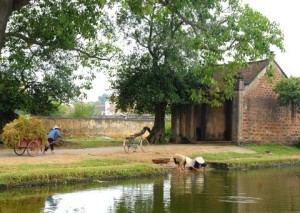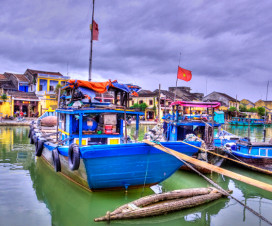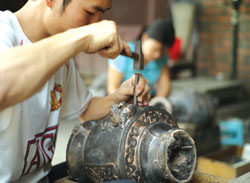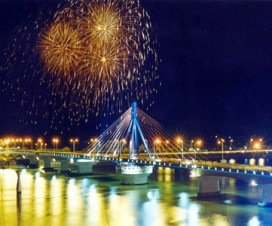 For every tourist who comes to explore the Northern Vietnamese culture, Duong Lam ancient village is a good suggested destination. In addition to the hallmarks of a traditional northern village, Duong Lam also offers visitors the heartfelt welcome of its country people. We guys have had a chance to experience this wonderful village.
For every tourist who comes to explore the Northern Vietnamese culture, Duong Lam ancient village is a good suggested destination. In addition to the hallmarks of a traditional northern village, Duong Lam also offers visitors the heartfelt welcome of its country people. We guys have had a chance to experience this wonderful village.
We can see it in the smile of a tea-shop owner near Mong Phu communal house, which we visited with a local volunteer acting as our tour guide.
Duong Lam is located 50km to the west of Hanoi. The unique village, which was recognised as a National Cultural-Historic Relic, has houses which are around 200 years old.
Of the nine hamlets within Duong Lam Village, Dong Sang and Mong Phu have maintained the most ancient houses: 441 and 350, respectively, among the total 956 traditional houses.
The old Duong Lam Village is famous for its homes made of laterite, a type of red soil. Most of these houses have their own courtyards surrounded by a laterite wall.
We stayed at Nguyen Van The’s house, which was built in 1703 and is one of the three oldest houses in Duong Lam. We ate a delicious lunch with his family of boiled chicken, vegetables and fried tofu, prepared by The’s wife and daughter-in-law.
“We inherited the house from our parents. We are making an effort to preserve the house although it is deteriorating,” The said. “We get a lot of foreign visitors and often talk with them about the life of the country people.”
The country is experiencing a general trend towards modernisation not only in the urban areas, but also in the rural regions, but the people of Duong Lam have preserved the customs of the rural people.
The village didn’t have the restaurants and souvenir shops of tourist destinations. Instead, the owners of the old houses were hospitable and ready to spend half the day talking with their visitors.
The’s wife introduced us to a soy sauce, peanut candy she made and told us about herself while we munched away.
Liked many women in rural areas, she got married when she was young, only 19, and had three children. She has been so busy taking care of her children, then her grandchildren, that she has only visited Ha Noi once, 18 years ago. “On TV, I see tall buildings, big supermarkets, shops and large roads with bright lighting. I can’t even imagine how the capital city has changed,” she said.
Both The and his wife are concerned that the old houses will disappear in the future if owners knock them down to build new cement homes.
Duong Lam also lures visitors to see its architectural relics, including the Mong Phu hamlet gate, the Mong Phu communal house, the Ngo Quyen imperial tomb and Mia Pagoda.
Attractions like the 500 year-old communal gate, the century-old banyan tree and the river wharf all bear the characteristics of Viet Nam’s northern countryside, but their unique characteristics set Duong Lam apart from other villages.
While many northern villages have hamlet gates, Mong Phu’s ancient gate was built to look like a house with a sloping roof.
On our one-day trip, we were able to visit four of the village’s 16 historic relics: Mia Pagoda, Ngo Quyen Tomb, Mong Phu communal house and Phung Hung Temple.
The communal house, built in 1684, combines the architectural style of the Kinh people (majority population in Viet Nam) with the timber floor of the Muong ethnic minority group. Festivals and folk performances usually take place in the large yard in front of the house.
The 73-year-old keeper told us that the restoration of the communal house was part of an ongoing VND200 billion (US$11.4 million) project to preserve historic monuments in Duong Lam, including the restoration of ancient wells and houses and a shrine dedicated to Chinese philosopher Confucius.
If Ha Noi’s old quarter and Hoi An’s ancient town are relics of an ancient urban lifestyle, then Duong Lam’s old village is a valuable relic of rural village life, said the keeper of the Mong Phu communal house.
Mia Pagoda, with 286 statues made of bronze, wood and clay, is one of the most beautiful pagodas in the north, said Tran Van The, our volunteer guide.
At the end of a day spent enjoying the historic relics of an age-old culture, we enjoyed some Duong Lam specialities: Mia chicken, Mong Phu soy sauce, Cam Lam tea and Dong Sang peanut candy. Visitors often bring these specialties home as gifts.
More and more young couples are flocking to the village to capture its traditional beauty in their wedding photographs. “We chose the location for its ancient houses and consider it a chance to both escape the stress of the city’s dusty streets and to feel the Vietnamese soul through the culture here,” said Nguyen Khanh Linh, a bride-to-be.
To know more about Duong Lam, you can check out this website.
Collected by Vietnamtravelblog.com




